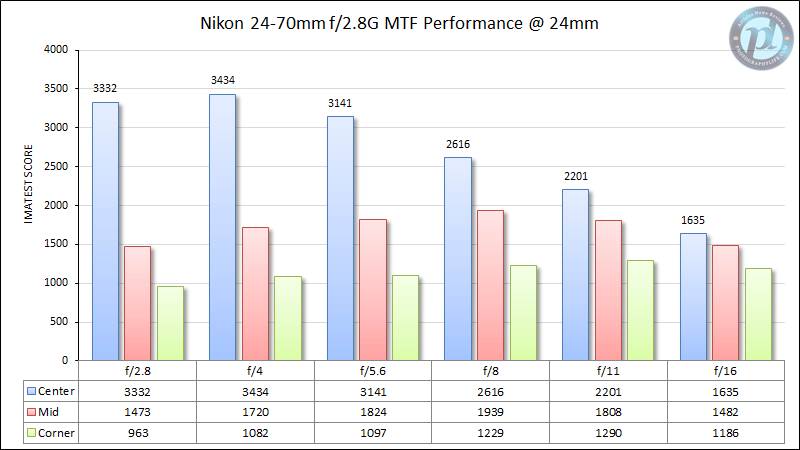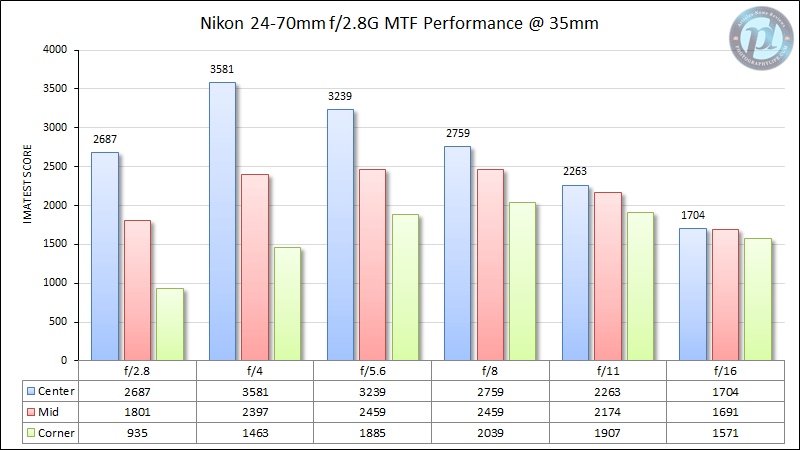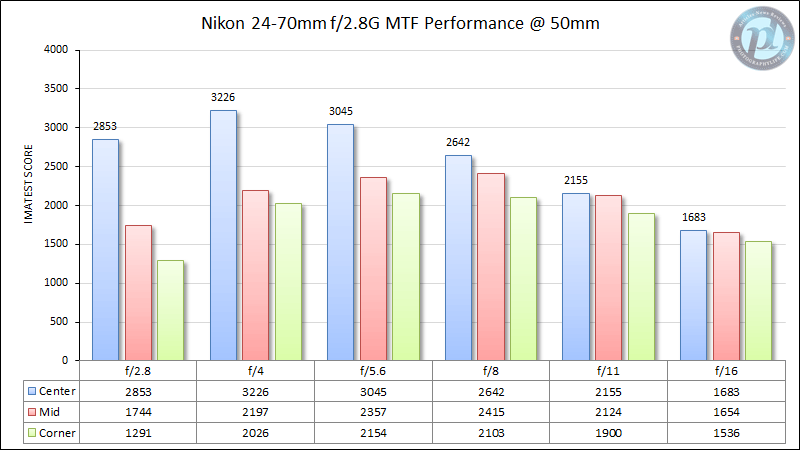Nikon 24-70mm f/2.8E VR vs Nikon 24-70mm f/2.8G
Now let’s take a look at how well the Nikon 24-70mm f/2.8E VR does optically compared to the previous-generation Nikon 24-70mm f/2.8G. Here are both lenses at 24mm:


The difference in center sharpness is pretty clear – the 24-70mm f/2.8G does noticeably better, especially at the f/2.8-f/4 range. However, take a look at how much better the new 24-70mm f/2.8E VR looks in the mid-frame and the corners. There is simply no comparison here, even when stopped down to f/8!


As we zoom in to 35mm, we can see that the situation does not get any better for the 24-70mm f/2.8G. While it is noticeably sharper in the center at f/4, the new 24-70mm f/2.8E VR simply blows it away everywhere else.


At 50mm, we can see that the older Nikon 24-70mm f/2.8G shows excellent performance, especially at f/4-f/5.6 range. Both lenses perform about the same at f/8 here.


Lastly, at the longest end of the zoom range, we can see that both lenses suffer sharpness-wise at maximum aperture. However, the Nikon 24-70mm f/2.8G is a clear winner here, showing visibly better center sharpness from f/2.8 to f/4. This is one of the main reasons why portrait photographers disliked the 24-70mm f/2.8E VR, as it is not as sharp as the 24-70mm f/2.8G in the center frame. Once stopped down to f/5.6-f/8, however, the 24-70mm f/2.8E VR is better, especially in the corners.
As I have pointed out earlier, when the new Nikon 24-70mm f/2.8E VR is directly compared to its predecessor, it shows slightly worse center performance, but has much better mid-frame and corner performance. So its sharpness is much more evenly spread out in comparison, making it a much better lens for photographing landscapes and architecture. This is especially noticeable when photographing subjects at infinity.
Lastly, let’s not forget that the 24-70mm f/2.8E VR has some bells and whistles such as fluorine coating and image stabilization that the 24-70mm f/2.8G does not. Image stabilization alone is a huge advantage, as it can save a lot of shots when shooting hand-held in low-light situations. Many of the images presented in this review were shot hand-held and being able to shoot without a tripod often saved me quite a bit of time and hassle. For example, I would have normally never risked to capture a shot hand-held at 1/10th of a second @ 32mm on a DX camera. Thanks to image stabilization, I was able to easily pull it off without even thinking about it:

Nikon 24-70mm f/2.8E VR vs Tamron SP 24-70mm f/2.8 Di VC USD
What if we were to compare the Nikon 24-70mm f/2.8E VR to the Tamron 24-70mm f/2.8 VC? Both lenses compete directly with one another, since they cover exactly the same range and feature image stabilization. Here are the two lenses at 24mm:


The Tamron 24-70mm f/2.8 shows similar characteristics as the 24-70mm f/2/8G, showing comparably good center performance and rather weak corner performance due to its field curvature. In fact, even stopping the Tamron down to f/8 does not bring it to the same sharpness levels the Nikon 24-70mm f/2.8E VR can get to.


Things don’t get any better for Tamron as we zoom in to 35mm. As you can see, the Tamron 24-70mm f/2.8 VC still have pretty poor corner performance in comparison to the Nikon 24-70mm f/2.8E VR.


At 50mm, Tamron starts out stronger in the center, but at the cost of mid-frame and corners. Here, the Nikon 24-70mm f/2.8E VR still reigns with its impressive overall performance. Once again, Tamron cannot get close to what Nikon can deliver even when stopped down to f/8.


Lastly, we can see that the Tamron 24-70mm f/2.8 VC gets significantly worse at 70mm. Now the Nikon 24-70mm f/2.8E VR is as sharp in the center and significantly better everywhere else at f/2.8, and once stopped down to f/5.6, it takes off big time without letting the Tamron catch up.
Overall, it is pretty clear that the Nikon 24-70mm f/2.8E VR is a much better lens sharpness-wise when compared to the Tamron 24-70mm f/2.8 VC. You also cannot compare the two in terms of autofocus speed and accuracy. Nikon is one step ahead of Tamron in autofocus performance and when it comes to image stabilization, I personally found Nikon’s VR to be about a stop better than Tamron’s, so Nikon leads there as well. Obviously, there is a huge difference in price between the two lenses, so one has to assess what lens fits their particular needs based on their budget.

Nikon 24-70mm f/2.8E VR vs Canon 24-70mm f/2.8L II
Last year I had a chance to test the Canon 24-70mm f/2.8L II on a number of different camera bodies, including the Canon 5DS. To my surprise, Canon’s updated 24-70mm f/2.8L II lacked the resolving power to be able to show all the details in the extreme corners. Take a look at the below unsharpened crop from the bottom right corner of an image:

I immediately thought that I had a faulty lens, so I requested another copy of the 24-70mm f/2.8L II to test, as it was hard to believe that such a high-end lens would yield such poor results. After a few weeks I was able to obtain another copy of the same lens and this time I put it on the Canon 5DS R, which lacks a low-pass filter. Here is the corner crop from the same area of the scene:

Ouch, this one turned out to be even worse! And no, this was not something one could blame bad focusing on, since here is how the center of the frame looked on the same image, showing plenty of detail (no sharpening applied):

After these two lens samples and the challenges I had with obtaining a sharp image from the center of the frame all the way to the extreme corners, I came to the conclusion that Canon’s 24-70mm f/2.8L II is simply not sharp enough to be able to resolve extreme corner details. This is especially true on a high-resolution DSLR like the Canon 5DS / 5DS R.
In comparison, here is what the extreme corners on the Nikon 24-70mm f/2.8E VR look like at the same aperture:

Although the crop is taken from a different scene, it is pretty clear that the Nikon 24-70mm f/2.8E VR is a much sharper lens at the edges of the frame.

Table of Contents